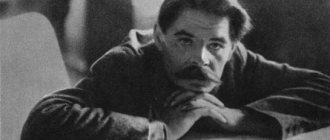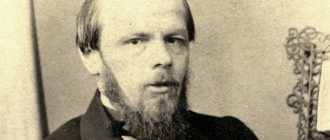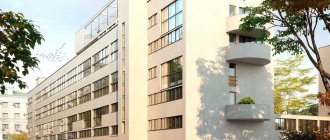The reference point for the creators of Stalin's high-rise buildings was the never-built building of the Palace of the Soviets. A high-rise building was to appear in the center of Moscow, which would be crowned with a hundred-meter statue of Lenin (larger than the Statue of Liberty in the USA). This house, 420 meters high, began to be built in 1931 on the site of the bombed Cathedral of Christ the Savior, but the war prevented the plan from being realized. The Soviet authorities did not abandon the idea of embodying the era in stone, and after the end of the war, a decision was made to build several high-rise buildings, which we today call Stalin's high-rise buildings.
Article on the topic Capital of the proletariat: what Stalin’s Moscow could have been like
There are many assumptions why Stalin decided to build such high-rise buildings in the post-war country. According to one version, the leader liked Gothic architecture, and they are somewhat reminiscent of Gothic cathedrals. According to another, the architects’ task was to “catch up and overtake America,” which began building skyscrapers at the end of the 19th century, while Moscow for the most part remained a low-rise city. The fact remains undeniable that almost every high-rise building has its own American prototype. True, this similarity is only external and noticeable from a certain angle.
All eight high-rise buildings were founded on the day of the 800th anniversary of Moscow, September 7, 1947. Seven of them, popularly nicknamed “seven sisters,” were built, but the eighth could not be completed. As conceived by the architects, the buildings were to become the new dominant features of the capital, creating a standard both in terms of the height of construction and its quality.
Residential building on Kotelnicheskaya embankment. Photo: Commons.wikimedia.org
Sun in Soviet apartments
The press of that time widely discussed technologies for the construction of high-rise buildings and, in particular, examined the mistakes of US builders. According to Soviet architects, American skyscrapers had little natural light, they were deformed by the wind, and when there were strong gusts, water in glasses even splashed on the upper floors. Soviet buildings should have been free of these shortcomings.
Administrative and residential building on Red Gate Square. Photo: Commons.wikimedia.org
Buildings of this height were built for the first time in the Soviet Union, and the advanced technologies and solutions used are still impressive today. For example, the high-rise building on Lermontovskaya Square was built simultaneously with the Krasnye Vorota metro station. To prevent the 138-meter building on the edge of the pit from tilting, the soil around the perimeter of the pit was artificially frozen, and the high-rise itself was built at an angle. When the ground under the building thawed after construction, the 100-meter-long colossus assumed a vertical position.
Seven sisters
The largest high-rise building was the main building of Moscow State University: its height was 280 meters. The rest of the “Moscow Sisters” are approximately the same height. Residential building on Kotelnicheskaya embankment - 176 m; the building of the Ministry of Foreign Affairs on Smolensko-Sennaya Square - 170 m; Hotel "Ukraine" on Kutuzovsky Prospekt - 170 m; administrative and residential building at the Red Gate - 134 m; Hotel "Leningradskaya" on Komsomolskaya Square - 138 m; residential building on Kudrinskaya Square - 159 m. Another high-rise building was to be built in Zaryadye. By 1953, the frame of ten floors was ready, but with the death of Stalin, construction was stopped. Subsequently, the Rossiya Hotel was built on the stylobate (part of the stepped plinth).
There were no more apartments like those in high-rise buildings in the USSR. Needless to say, passers-by looked with envy at the lucky ones who entered their entrances? Representatives of the Soviet elite and nomenklatura received housing in such houses. At various times, Faina Ranevskaya, Konstantin Paustovsky, Andrei Voznesensky, Vasily Aksenov and other artists, painters, writers, officials, builders and politicians lived in the house on Kotelnicheskaya Embankment. The high-rise building on Kudrinskaya Square was popularly called the “house of aviators”: many test pilots and aircraft designers lived here.
Residential building on Kudrinskaya Square. Photo: Commons.wikimedia.org
LiveInternetLiveInternet
Quote from repman
Read in full In your quotation book or community!
“And when the fear recedes, for a second, a short moment, I will soar on wings over the boulevard and the high-rise, And, flying over the Yauza, whistling loudly as best I can, I will fly in an arc jokingly in the black night, by the way.”
The residential building on Kotelnicheskaya Embankment in Moscow is one of the “high-rise buildings”, built at the mouth of the Yauza in 1938-1952. The authors of the project are D. N. Chechulin, A. K. Rostkovsky, engineer L. M. Gokhman. Lavrentiy Beria oversaw the construction, including insisting on choosing a site for the construction of the house.
The height of the building is 176 meters. This is the third tallest Stalinist skyscraper (after Moscow State University and the Ukraine Hotel). It was built, of course, by prisoners who lived nearby, in “Lagpunkt” (on Taganka). The lists of residents were approved by I.V. Stalin himself. Therefore, some of the apartments were occupied by all kinds of KGB workers, party and military leaders, the other part was occupied by famous scientists, artists, and writers.
“Our people will live in our house.” (I.V. Stalin about the high-rise building on Kotelnicheskaya)
The exact number of apartments in this building has always been a mystery. First because of secret agents who lived in apartments without numbers, then because of the “new Russians” who bought them en masse and united and separated apartments among themselves. We can say that there are about 700-800 apartments in the building.
The main architect of the high-rise was Dmitry Nikolaevich Chechulin. This man was generally a general among the architects of the Soviet period; he began working under Stalin and finished under Brezhnev. In addition to the house on Kotelnicheskaya, he built, for example, the Rossiya Hotel, the House of Soviets of the RSFSR (White House), the Moscow swimming pool, and residential buildings on Kutuzovsky and Leninsky Avenues. We can see his image in the famous film “True Friends”.
The high-rise building was built in two stages. Before the war, there was the so-called “building A”, which stretches along the river. And after the war, the architect “inscribed” the high-rise building itself, adjacent to the building in the place where the Yauza flows into the Moscow River.
Chechulin was an unusual person for his time. He was not afraid to check the orders of Stalin himself for expediency. In fact, it was planned to build not seven, but eight Stalinist high-rise buildings. The last, the highest, was supposed to stand near the Kremlin itself. But Chechulin understood perfectly well how this would disfigure and obscure the center of Moscow, and he delayed, delayed construction, and rejected all proposals. And it lasted so long that the Rossiya Hotel was built instead of a high-rise building.
He paid for this, thank God, not with time, but simply by getting an apartment in his own brainchild, not on a high floor, as he dreamed, in order to see the whole city from there, but at the very bottom.
The high-rise building on Kotelnicheskaya is like a city within a city. This house has everything: shops of all kinds, a library, a school, a kindergarten. There is also a cinema. Muscovites know him well.
Now this is the only cinema in Moscow. And in the old days people would flock here for the premieres of new films with Belmondo or Delon, and even earlier for Jean Gabin or the films of Akira Kurosawa.
“Illusion” is still working. Nothing has changed here. The same cozy cafe, the same live pianist playing to silent films, the same rare premieres. Plus, this cinema is considered something of a dating club for intelligent single people.
There was even a museum set up in the apartments of some famous residents of the building. For example, now there is a house-museum of Galina Ulanova.
Composer Nikita Vladimirovich Bogoslovsky (“Dark Night”, “Scows Full of Mullets”, “Beloved City”, “Lizaveta”) lived in this house. He was a great joker. His favorite pastime was giving his neighbors, fellow composers, a heart attack...
One day, composer Anatoly Grigorievich Novikov (“Smuglyanka”, “Oh, the roads...”) late in the evening wanted to admire Moscow. But, approaching the window, he suddenly noticed Nikita Bogoslovsky on the other side, pale as death, dressed in a sheet, howling ominously. The floor was not high, but not low either. Novikov recoiled in horror from the window, and there they continued to howl: “Oooh! Wow!” Plucking up courage, Novikov went to the window and saw that Bogoslovsky was standing in the lifting basket of a machine for working at high altitudes. It turned out that Bogoslovsky had agreed with the driver to play the fool for a tenner...
Another time, our joker called the composer Dmitry Shostakovich, and in a changed voice announced that they were calling him from intelligence, and the agents were reporting that there would be a robbery in his apartment that night. The robbers will presumably be dressed as doctors. Shostakovich, of course, called the police, and they set up an ambush. In the dead of night, the ambulance rang, and a crying voice said that the great composer Shostakovich was feeling bad. Well, of course, the doctors came on call, where the cops screwed them over. In the morning, the repentant Bogoslovsky himself confessed and paid fines for false summons and petty hooliganism. Or they could have imprisoned...
So many famous people lived in the high-rise that there are not enough memorial plaques for everyone. It is not known on what principle they hung the boards for some and not for others. For example, there is a board by Konstantin Paustovsky.
But there is no plaque of everyone’s beloved Faina Georgievna Ranevskaya, with whose name most Muscovites associate this house. Ranevskaya received a two-room apartment here, it seems, on the second floor in the left wing of the building. She said that she lived “above bread and circuses” (bakery and cinema).
Her neighbor in the stairwell was the writer and poet Alexander Trifonovich Tvardovsky, who called her “my great neighbor.” One day Tvardovsky lost the keys to his apartment, couldn’t get in and really wanted to go to the toilet. He asked Ranevskaya to use her toilet. She, of course, let him in, but then when she met him she shouted to the whole yard: “Alexander Trifonovich, my closet is always at your disposal!”
Her other neighbor was the composer Vano Ilyich Muradeli. She told him: “You are a swindler, my friend, you don’t hit a single note, mu instead of mi, ra instead of re, de instead of do and li instead of la.”
“I would send you, but I see you are from there.” (F.G. Ranevskaya).
Inviting neighbors to visit, she said:
- If the bell doesn't work, knock your feet. - Why with your feet, Faina Georgievna? - Well, you won’t come to me empty-handed!
Before her death, her sister, Bella Feldman, settled with her, who was amazed that Ranevskaya was not rich at all. The last years of her life, the actress did not live in this house, but in Yuzhinsky Lane. Due to her popularity, she, of course, should have been buried at the Novodevichy cemetery, but she modestly asked to be buried with her sister at the Donskoye cemetery. She was an amazing person...
Alexander Shirvindt lives in this house. He wrote the book “Schierwindt, wiped off the face of the earth” (that was the name of the city in Prussia), in which he several times mentions the high-rise building on the embankment.
Shirvindt proposed introducing three new orders for our officials - “for partial, temporary and final loss of honor and dignity”...
In the same book, he notes that the old residents, who have long since retired, cannot pay for huge apartments in the famous building and are forced to sell them to all kinds of cool people.
One day, his old neighbor, the general’s widow, met Shirvindt and complained that she had to sell her apartment, but the main problem was that she could not find Jews to renovate. What do the Jews have to do with it? - Shirvindt was surprised. “Well, of course, I have to do European-quality renovations here,” the old lady answered...
The high-rise is visible from afar. And many streets in the center of Moscow, like rays, are directed directly towards it. This is how it looks from Taganskaya Square.
And in many apartments now live the heirs of the great ones, who were simply lucky to be born into the right family. The “three ruble” in this house can be exchanged for several other very decent apartments, rent out one of them and never work again.
A curious story is how the famous actress Lidia Nikolaevna Smirnova got an apartment in the house. She and her husband, cameraman Vladimir Rappoport, lived in a communal apartment and dreamed of moving out of it.
Vladimir Rappoport was also a celebrity, he made films such as “Quiet Don” or “The Young Guard,” but no matter how much he went through the authorities, nothing worked. He simply did not know how to ask, and mumbled, saying that it was good for them to live as is.
And Lidia Nikolaevna decides to take a desperate step - she writes a petition to Beria himself, which at that time was a strict violation of subordination, and such jokes could have led to very bad consequences.
But Smirnova turned out to be one of Beria’s favorite actresses and he immediately imposed a resolution: “Give them an apartment!”
Before they had time to inspect the new apartment, Beria was arrested and shot. All his decisions were vetoed and Smirnova fell into complete despair. And suddenly a call from “there”: “Why haven’t you moved yet?!” One of the few decisions of Beria was not canceled, because the new bosses also turned out to be a fan of Lydia Nikolaevna.
And when she arrived to look at the new apartment, she fainted from happiness; the poor thing rode the elevator up and down in this state until her neighbors discovered her. Already very old, before her death, Smirnova said that now she is saved only by the view from the high-rise window of her beloved Moscow.
The famous Irina Nikolaevna Bugrimova, a Soviet circus artist, lion trainer, and the first female trainer in the USSR, lived in the same house. Her husband was the famous motorcycle racer Alexander Buslaev.
True, they divorced quite quickly. Bugrimova later said that a woman tamer rarely has a good personal life, because taming a husband is much easier than a lion or a tiger.
She was the first to perform with a group of male lions. It is very dangerous. The fact is that lions live in prides; in one pride there are not two seasoned males, and if these are together, then their aggressiveness increases by an order of magnitude.
Bugrimova had about 80 lions in her group. The success was wild, but Irina Nikolaevna was torn to pieces by lions more than once. And several times she ended up in the arena covered in blood.
In 1976, during a tour in Lviv, the lions suddenly rebelled once again and attacked Bugrimova right in the arena. The assistants fought her off from the predators, but after this incident the trainer decided to stop performing.
The leader of this informal male lion pride was a huge lion named Caesar. All the other lions were afraid of him. He competed for 23 years, which is an incredibly long time for a lion. But he became decrepit, could no longer perform, and it was decided to write him off to the zoo. But Bugrimova stood up for him, saying there was no reason to put him behind bars, took him to her place and dragged a huge lion with her everywhere. So he, in part, was also a resident of the famous house on Kotelnicheskaya.
When Bugrimova performed in the arena with other lions, Caesar sat backstage in a cage and was very worried that the act was going on without him. He rolled around the cage and whined, and when the trumpets sounded, he threw himself against the bars with his chest to take his place of honor in the arena among the others. One day after the number he was found dead on the floor. Leo died from grief that he could no longer perform.
This house, a high-rise residential building on Kotelnicheskaya Embankment, holds many interesting stories. There is only one house in the city, and I still have to write about it!
Here is a very, very abbreviated list of famous residents (both of them):
- Aksenov, Vasily Pavlovich - Bogoslovsky, Nikita Vladimirovich - Bugrimova, Irina Nikolaevna - Voznesensky, Andrey Andreevich - Yevtushenko, Evgeniy Alexandrovich - Zharov, Mikhail Ivanovich - Zykina, Lyudmila Georgievna - Litvinova, Renata Muratovna - Luchko, Klara Stepanovna - Lyubimov, Yuri Petrovich - Milyutin, Yuri Sergeevich - Mokrousov, Boris Andreevich - Nagiev, Dmitry Vladimirovich - Ognivtsev, Alexander Pavlovich - Paustovsky, Konstantin Georgievich - Ranevskaya, Faina Georgievna - Smirnova, Lidia Nikolaevna - Tokarev, Vilen Ivanovich - Ulanova, Galina Sergeevna - Chechulin, Dmitry Nikolaevich - Shirvindt, Alexander Anatolyevich - Shifrin, Efim Zalmanovich...
Source
Soviet Icarus and jasper columns
Stalin’s high-rise buildings became overgrown with myths even during construction.
Legend: “ When the design of the Foreign Ministry building was brought to Stalin for approval, he drew the spire directly on the drawings with his famous blue chemical pencil. In order not to radically change the project, the spire was made of plywood. And since then, every night of December 31, when the country is busy eating Olivier salad, a team of secret workers climbs onto the roof of the high-rise and renews the peeling paint. The paint thickens in the cold, does not apply well and bubbles. This is especially noticeable from the Kievsky railway station.”
In fact, the true history of the appearance of the spire on the Foreign Ministry building is unknown. According to one version, Stalin allegedly completed the spire on the project not during its approval, but when the building was already erected, and the builders had no choice but to finish it as soon as possible using scrap materials.
Legend: “ During the construction of the Chemistry Faculty of Moscow State University, jasper columns from the Cathedral of Christ the Savior were used, which were preserved after its demolition, and in general in the building of the country’s main university there are many fragments from a variety of destroyed architectural monuments. For example, the Reichstag."
Article on the topic
A forgotten symbol of communism. Why the Palace of Soviets was never built (01/10/2014)
In fact, the chemistry department was once equipped with captured German fume hoods, so this rumor has some basis. As for the jasper columns, not a single historical source mentions that they actually existed in the Cathedral of Christ the Savior.
Legend: “In the house on Kotelnicheskaya Embankment there is a special network of secret passages along which vigilant security officers walked and eavesdropped on the residents’ conversations. According to some residents, voices were sometimes even heard from these passages.”
In fact, the high-rise does have office space, but the voices of plumbers and electricians can be heard from there.
Legend : “Under the main building of Moscow State University there is a branch of the secret government metro, which can be reached through the checkpoint of zone “B”.
In fact, not a single official statement has ever been made about Metro-2 for the government from the Kremlin to Vnukovo Airport, although reports about its existence and even diagrams have repeatedly appeared in the press.
Main building of Moscow State University. Photo: Commons.wikimedia.org
Legend: “Prisoners participated in the construction of the main building of Moscow State University. In order not to waste time on escort, they decided to settle them on the 26th floor of a building under construction: the guards decided that it would be simply impossible to escape from there. However, one resourceful convict made something like a hang glider out of plywood and boldly stepped into the abyss.” At this point, versions of the legend differ. According to one of them, the prisoner was shot while still in flight, according to another, he was caught upon landing, and Stalin, admiring his courage, freed him, and according to the third, he was able to fly across the Moscow River and hide.
In fact, parachute jumps were made from the main building of Moscow State University, so such a flight was quite possible. But there is no information confirming this particular story.
Hotel "Leningradskaya". Photo: Commons.wikimedia.org
Why the famous residents of the legendary high-rise building on Kotelnicheskaya Embankment were not happy
Home of lonely hearts...
From the moment of its construction, this house was considered the most prestigious in Moscow. Apartments in a high-rise building on Kotelnicheskaya Embankment were the ultimate dream of the Soviet elite, but they were given to people who had special services to the country. State prize laureates, scientists, artists, and artists lived here. But for some reason, in luxurious, fully furnished apartments with panoramic views of Moscow, they could not be happy.
Lidia Smirnova
Before becoming a real star, Lydia Smirnova went through many trials: she endured humiliation from her relatives, went hungry, and lived in unbearable conditions. She was already a star, her husband Vladimir Rapoport, a famous cameraman and director, was a three-time winner of the Stalin Prize, and they huddled in some tiny room in a communal apartment. Lydia Smirnova wrote a letter to Beria himself asking him to improve her living conditions. And she got an apartment in the best building, in the same building as Faina Ranevskaya.
There was no need to buy furniture, everything was already in place. She and her husband moved into a luxurious apartment. But the happiness was short-lived. Soon Lydia fell in love with director Konstantin Voinov. They rented a room in which they planned to live together.
Konstantin Voinov, tormented by remorse, broke up with his family, and Lydia Smirnova came and said that she could not leave her husband. For many years she was torn between her husband and her lover. Vladimir Rapoport was seriously ill for a long time, she looked after him, trying to alleviate his suffering as much as possible. He was given only 2-3 years to live, but Vladimir Rapoport lived, thanks to her, 13 years. Later, history repeated itself with Konstantin Voinov: a serious illness and many years of struggle with death.
After the death of her husband, and then her beloved man, Lydia Smirnova lived alone. She died at the age of 95 in Moscow.
Faina Ranevskaya
She lived above the Illusion cinema and bakery, located right in the house. And she never stopped joking about this: “I live above bread and circuses.” She was always lonely, finding solace only in work and also in the endless devotion of her Boy, a mongrel dog, once picked up on the street. But soon Faina Ranevskaya began to ask that she be given the opportunity to change her place of residence. It was very noisy in the bakery under her windows, wooden pallets often rattled, and Faina Georgievna could not rest. They met her halfway and provided her with other housing.
Lyudmila Zykina
The whole country knew and loved this singer. When the singer was given a 100-meter apartment in a famous building, she said admiringly: “Well, where can I get that much?” Having been married several times, Lyudmila Zykina was completely alone at the end of her days, and only an au pair was waiting for her at home. As you know, Zykina loved antiques; her collection was one of the best in the country. Looking at all this splendor, the housekeeper sometimes asked who would get it. And Zykina answered: to the people. But after the singer’s death, a series of lawsuits and proceedings followed, and the apartment was inherited by the celebrity’s nephew.
Galina Ulanova
The great ballerina devoted her entire life to her profession. Of course, there were men, admirers and husbands in her life. But ballet always came first. Galina Ulanova consciously abandoned the joy of motherhood, believing that the stage and children cannot coexist in her life. In everyday life, the world ballet star was completely helpless. She didn’t know how to cook, didn’t know where utility bills were paid, and in the event of some kind of breakdown, she didn’t even know how to call a repairman. In the 1970s, she felt absolutely alone, but fate gave her a meeting with the closest and most important person in her life.
Journalist Tatyana Agafonova from Komsomolskaya Pravda came to interview her. Soon the correspondent quit the newspaper, devoting herself to the great ballerina. Ulanova called Tatyana her adopted daughter, loved her very much, and even made a will for her. They lived together in a house on Kotelnicheskaya. Tatyana quickly organized the life of the great ballerina and could very quickly resolve any issue. Unfortunately, Galina Ulanova outlived her adopted daughter. Tatyana Agafonova died from cancer. The ballerina took her departure very hard and died after almost 4 years of complete loneliness.
Irina Bugrimova
The famous trainer managed to work with hundreds of lions during her creative career. Dangerous predators presented their large muzzles to her for stroking and obediently sat on the swings, which lifted them under the circus dome. For 40 years, Irina Bugrimova entered the cage with predators again and again, despite the rather serious injuries she received in the arena. Only at the age of 67 did she leave the profession.
Irina Bugrimova lived alone in a house on Kotelnicheskaya. And she didn’t love this house. Already in adulthood, she complained that the house had never undergone major repairs, and all communications had long been in need of replacement. In 1981, her apartment was robbed, taking away a unique collection of diamonds. The incident was unthinkable in its audacity; even Galina Brezhneva was suspected of involvement in it. This incident did not add to Irina Bugrimova’s love for her home.
The famous trainer lived alone until the end of her days, spending her savings on paying au pairs, nurses, and cooks. Only the faithful cat Nero brightened up her loneliness. She died in 2001 from a heart attack.
Huge pompous buildings, legendary houses, made in a complex combination of Russian Baroque and Gothic styles, the so-called Stalinist Empire, built from 1947 to 1953, are known as the “seven sisters”. Each of these buildings has its own fascinating history. Even today they proudly flaunt in the capital, reminiscent of a bygone era.
Source
Did you like the article? Share it with your friends!
1341
How much is history worth?
In the first years after the collapse of the Soviet Union, Stalin's high-rise buildings were the most desirable housing. The fact is that the apartments in these houses were departmental, which means that in Soviet times it was impossible to live in, for example, the “House on Kotelnicheskaya Embankment” for any money. After the collapse of the country and privatization, the situation changed. The owners of the apartments were the children and relatives of departed representatives of the Soviet elite, who often parted with their inheritance without much trepidation. Representatives of the new “elite” began to appear in high-rise buildings, but over time, the demand for apartments in such buildings began to fall: elite new buildings appeared on the capital’s real estate market. “The demand for Stalinist high-rise buildings has greatly decreased, since the apartments in these buildings are expensive and have a non-functional layout that often cannot be remodeled. Therefore, buyers often choose new buildings with more spacious apartments, larger square footage, and a modern standard layout,” said Olesya Mandzyak, head of the luxury real estate department at Delta estate . However, there is a category of people who still dream of an apartment in a Stalinist high-rise. “For many, especially for visitors, living in such a house is the ultimate dream. And for a considerable number of Muscovites too. For example, I know one official who has an apartment in the famous “House on the Embankment” (government house), but nevertheless dreams of housing in a Stalinist high-rise,” Vadim Lamin, managing partner of the Spencer estate real estate agency,
Article on the topic
Stalin's skyscrapers: Hotel "Ukraine" celebrates its anniversary
But even if you have a great desire and a lot of money, it will be difficult to purchase the desired apartment in a Stalinist high-rise building today. According to experts, many apartments in these buildings were purchased for investment purposes in the early 2000s and have not yet entered the market, and most often no more than 10 apartments are sold per year. Their cost varies depending on the renovation, number of rooms and floor. “The cost of housing in Stalinist high-rise buildings is very high. This is due to the fact that homeowners do not adequately assess the situation on the real estate market. For example, apartments on Kotelnicheskaya Embankment cost from $9,000 to $20,000 per sq. m. m,” Mandzyak said. “The range of prices for apartments in Stalinist high-rise buildings is very large,” said Nina Kuznetsova, founder of Urban Realty . — The lowest cost per square meter is at 11 thousand dollars, and the highest is at 20 thousand dollars. This difference is due to a large set of parameters describing the apartments in these buildings: this is the actual address of the high-rise, and the square footage along with the planning solution, as well as the section, floor and view from the windows. An important factor is the condition of the apartment and even the personality of the former owners. On average, a square meter in a Stalinist high-rise building today costs 13–15 thousand dollars per square meter.”
See also: Photos of the Moscow metro in the 1930s →
Who lives today in the former apartments of Soviet legends
Russian Look
Apartment of Bulat Okudzhava (pictured on the left) Russian Look
Komsomolskaya Pravda found out who owns the square meters of the most popular people of the Soviet era in Moscow today.
The passions in the life of Vladimir Mayakovsky reached their highest boil when he lived in a two-story house on Taganka. (The current address of this house is Mayakovsky Lane, 15/13.) Then the author of “A Cloud in Pants” shared living space with his beloved Lilya Brik and her husband Osip. The most famous people came here, in two rooms on the second floor - Boris Pasternak, Sergei Eisenstein, Theodor Dreiser. Meetings of the creative association “Left Front of the Arts” were held here every week. From here Mayakovsky, shot through the heart, was taken on his final journey - to the cemetery.
Until 1972, there was a poet’s museum here, then it was transferred to Lubyanka.
“In recent years, everything has been posted here. For some time, this house was rented by the South Korean Embassy, and then the office of a company selling cosmetics was set up right in Mayakovsky’s apartment,” says Valentina Smirnova, a fan of the poet.
The woman has been trying for several years to ensure that the historic building is used with more respect. He proposes to create a Museum of Russian Futurism here.
Externally the house is in very good condition. The door is closed, the windows are hidden behind the blinds. “There is no one in the building,” the guard assures. — It’s been two years since all the offices moved out. We’re just… protecting.”
However, advertisements for the delivery of a building or its individual parts can be found on the Internet. “The mansion of the late 19th century with a total area of 525 sq. m. m (architectural monument). Complete reconstruction - 2003.” On the specified phone number we were informed that “the offices have already been rented out.”
As journalists found out, the house now belongs to a private individual. “The house has the status of a monument of federal significance,” explained the Moscow Department of Cultural Heritage. “Our task is to ensure that the owners of such houses do not break the laws. One of the main requirements is that the façade of the building cannot be rebuilt. But the owner doesn’t violate anything.”
Okudzhava
As you know, the monument to Bulat Okudzhava stands on Arbat between houses 45 and 47, behind the bronze monument to the bard there are benches and a stylized arch opening. Only its original is a hundred meters to the left.
“This is the same arch, the Okudzhavo arch,” local resident Alla shows us, leading us into the courtyard. — Arbat, 43. There was a wooden building here, and, as far as we know, Okudzhava’s family lived in it. And then they were given a room here, in a communal apartment. Bulat Shalvovich’s family lived over there, on the fourth floor.”
The future poet and composer lived with a break of several years within these walls until his 16th birthday, then moved to his relatives in Tbilisi. But Arbat, 43, is considered his main Moscow home.
The windows of that same three-room apartment overlook the courtyard and Arbat. “In the 80s, in the room where Okudzhava himself grew up, there was a family of an ordinary nurse,” says pensioner Viktor Nikolaevich, excitedly tinkering under the hood of an old Moskvich-412. “My daughter at school was friends with that woman’s daughter, she visited the apartment more than once, but, of course, there weren’t any of Okudzhava’s things there anymore, and renovations were done more than once after that.
As a woman from a neighboring apartment said, in the 90s, according to documents, the communal apartment was combined into one apartment. She changed owners several times. The current owner purchased it two years ago. According to neighbors, he is a businessman, but he does not live here himself, but rents it out. Now - to foreigners from Europe, who are almost invisible.
As realtors said, renting a three-room apartment in such a house on Arbat today costs no less than 150 thousand rubles a month.
Ulanova, Zykina and “6 frames”
Pensioner Nina Andreevna is whileing away her time on a bench near the famous Stalinist skyscraper. She remembers very well the star inhabitants of this building: apartments in the 26-story building on Kotelnicheskaya Embankment (1/15) have been given to popular artists and scientists since the early 50s. The woman worked in this house for decades in a variety of positions - from a cleaner to an elevator operator.
“I’ve been to the Bolshoi Theater eight times,” she says proudly. — Galina Sergeevna Ulanova gave me invitations. Celebrities were completely different back then. Ulanova shone on stage, but dressed very modestly in life.”
Nina Andreevna knows exactly who is occupying whose apartment these days. “Lyudmila Zykina has a niece in her apartment, actress Marina Ladynina has her son, actor Zharov has a daughter,” says Nina Andreevna. — I know for sure that his descendants also live in the home of the writer Paustovsky. After the death of Klara Luchko, her husband lived in the apartment. But in February of this year he also died. And the couple was very beautiful.”
But the living space of Nonna Mordyukova and Evgeny Yevtushenko, according to the woman, has long been sold. Who's buying? “Yes, these new Russians, of course,” says Nina Andreevna. “Well, there are a lot of Caucasians here.”
Realtors say that the prices for most apartments (there are practically no one-room apartments here, mostly two-room apartments and three-room apartments) in the building on Kotelnicheskaya Embankment exceed $1 million.
Now “acting” stars also live in the house: Alexander Shirvindt, Dmitry Nagiyev, Valery Nikolaev, comedian Efim Shifrin, singer Willy Tokarev, artist from the TV show “6 Frames” Andrei Kaykov.
Few people know that deputies now sit in Andrei Mironov’s former home. The future actor spent the first 19 years of his life in one of the apartments at Petrovka 22, from 1941 to 1960. Then the family moved to another area. And now the Moscow City Duma is located in this house.
“Since the 20s of the last century, the Zhirkost housing cooperative was located here; these were communal apartments,” said the press service of the Moscow City Duma. — It is known that Andrei Mironov’s parents had a room on the third floor. He really lived here. But the room was not preserved in its original form; the building was rebuilt several times.”









